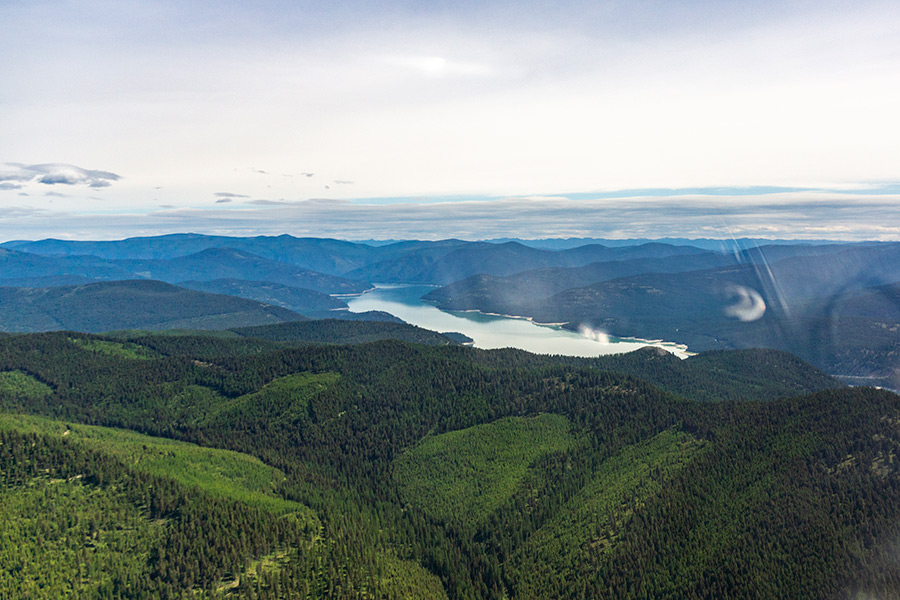Debate over the future of a 1,200-mile national scenic trail, a portion of which would track through the state’s most delicate chunk of grizzly bear habitat, is pitting trail planners against wildlife advocates who say the sanctity of the Yaak Valley hangs in the balance.
At the center of the debate is the Pacific Northwest National Scenic Trail (PNT), which travels through eye-popping terrain in the United States, linking diverse landscapes and communities throughout the Pacific Northwest. Beginning at the Continental Divide in Glacier National Park, the trail travels more than 1,200 miles through Montana, Idaho and Washington before reaching the Pacific Ocean near Cape Alava.
In 2009, Congress designated the PNT as a National Scenic Trail, christening it as one of 11 National Scenic Trails through a rider to a must-pass Omnibus Bill. In August 2015, the U.S. Forest Service established the Pacific Northwest National Scenic Trail Advisory Council, bringing together a group of stakeholders to help inform the future of the trail.
But as trail proponents move forward with plans to connect existing roads and trails, build new ones and publicize the route as a National Scenic Trail, conservationists worry about a proposal to punch a route directly through the heart of the remote Yaak Valley, which is home to Montana’s most fragile population of grizzly bears.
Members of the Yaak Valley Forest Council are mounting a campaign to raise awareness about the unforeseen consequences of building a trail through critical core grizzly bear habitat while proposing a reroute that skirts the Yaak and leads hikers through a southern corridor, past the communities of Eureka, Libby and Troy. Critics of the trail worry that as it gains popularity and increased use, as has occurred on the Appalachian National Scenic Trail and Pacific Crest National Scenic Trail, the Yaak’s recovering grizzly bear population — only about 25 exist in the Yaak portion of the Cabinet-Yaak Grizzly Bear Recovery Zone — will suffer.
Spearheading these efforts has been Rick Bass, the nature writer, conservationist and longtime denizen of the Yaak, who recently organized a three-day press trip to promote his proposed reroute and implore on bended knee Montana’s congressional leaders to take action.
“I have no real quarrel with another trail; I just don’t want it to traverse this last beleaguered patch of bear habitat,” Bass said.
“If the Pacific Northwest Trail were even one-sixth as popular as the California-to-Canada Pacific Crest Trail (which the PNT intersects), it could attract 1,000 permitted ‘thru hikers’ a year,” Bass wrote in a recent op-ed. “They might not all make it as far as the Yaak Valley, and if they did, they might not make contact with a bear. But any grizzly-human encounter is dangerous, for the bear more than the human. A bear that becomes acclimated to hikers’ campfires and trash, to searching tents for Cracker Jack and Clif bars, soon becomes a ‘problem’ bear and then a dead bear.”
Bass and other members of the Yaak Valley Forest Council support a scenic alternative re-route that bypasses the Yaak and cuts to the south of the Kootenai River, as identified by the late grizzly biologist Chuck Jonkel over 40 years ago. Called the “Jonkel re-route,” Bass said it avoids directing a high volume of thru-hikers into designated core grizzly habitat while providing greater economic opportunities for the rural towns of Eureka, Libby and Troy.
The Yaak covers roughly 1,000 miles of the 2,600-square-mile Cabinet-Yaak Grizzly Bear Recovery Zone, furnishing about 25 grizzlies with core habitat. The entire ecosystem supports about 55 or 60 grizzly bears, according to U.S. Fish and Wildlife Service biologist Wayne Kasworm, far less than the robust designated recovery zones in the North Continental Divide and Yellowstone ecosystems.
Grizzly bears are protected as a threatened species under the federal Endangered Species Act and cannot be hunted in the Lower 48 states.
Today, thanks largely to an augmentation program that Kasworm helped establish, the population of grizzly bears in the Cabinet-Yaak Ecosystem shows a projected growth rate of 2.1 percent annually.
Further fragmenting the delicate corridor would be detrimental to both people and bears, Bass said, while publicizing the area as a destination for backpackers could lead to an uptick in human-bear conflicts, even if education campaigns and food-storage orders were in effect.
“Already, hikers are wandering through the Yaak Valley backcountry, directed there by a trail website, and leaving messy campsites in their wake,” Bass wrote.
The proposed reroute has met pushback from trail proponents and forest officials, who have raised concerns about its costs while disputing the impact it will have on grizzlies.
In a briefing paper, Pacific Northwest Trail program manager Matt McGrath said Forest Service estimates the reroute “would require construction of more than 40 bridges to eventually move the PNT off of these roads as required by law with an estimated cost of more than $8.2 million. This proposal also fails to meet the National Trails System Act standards for maximum outdoor recreation potential.”
For Bass, the cost of allowing a tenuous grizzly bear population to slip toward extinction carries far greater costs.
Under the current proposal, he said, 76 miles of the PNT’s total length will pass through the Cabinet-Yaak Grizzly Bear Recovery Zone, while a lower-impact, southern alternative route would dramatically reduce the potential for bear-human conflicts.
